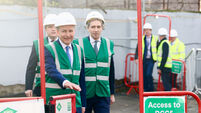Pope keeps on fiddling while Irish wing of the Church of Rome burns
I think perhaps I was hoping for something profound and yet simple, some assurance that a leader who, after all, occupies a special position in the hearts and minds of Irish people really got it, really understood the damage that has been done.
Above all, I think I was looking for a recognition that the church, as well as damaging the lives of so many, had also inflicted deep wounds on itself and its authority.















